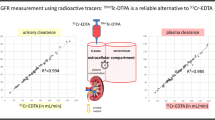Abstract
It has been suggested that sodium pertechnetate 99mTc millimicrospheres can be used to measure Kupffercell function. We studied animals and humans to show whether the clearance and catabolism of 99mTc-labelled millimicrospheres can be used as a measure of Kupffer-cell function. Comparison with albumin 125I-microaggregates clearance of human serum albumin failed to demonstrate that they can be used for this purpose. We suggest that their blood clearance is mainly an expression of liver blood flow.
Similar content being viewed by others
References
Benacerraf B, Biozzi G, Halpern BN, Stiffel C, Mouton D (1957) Phagocytosis of heat-denatured human serum albumin labelled with 131I and its use as a means of investigating liver blood flow. Br J Exp Pathol 38:35–48
Caster WO, Poncelet J, Simon AB, Armstrong WC (1956) Tissue weights of the rat. I. Normal values determined by dissection and chemical methods. Proc Soc Exp Biol Med 91:122–126
Donovan AJ (1967) The effect of surgery on reticuloendothelial function. Arch Surg 92:247–250
Ferlin G, Perelli R, Bonsato N, Rota G (1973) Reticuloendothelial clearance of 99mTc-albumin millimicrospheres. J Nucl Biol Med 20:100
Frier M, Hesslewood SR (eds) (1980) Quality assurance of radiopharmaceuticals. Nuclear Medicine Communications special issue. Chapman and Hall, London, p 27
Ilio M, Wagner HN (1963) Studies of the reticuloendothelial system (RES). I. Measurement of the phagocytic capacity of the RES in man and dog. J Clin Invest 42:417–425
Keene WR, Jandl JH (1965) Studies of the reticuloendothelial mass and sequestering function of the rat bone marrow. Blood 26:157–175
Reske SN, Hock A, Vyska K Feinendegen LE, Ebersoldt F (1978) 99mTc- and 131I-labelled human serum albumin millimicrospheres (HSA-MM) for measuring the functions of the reticuloendothelial system (RES). Nuklear-medizin 2:836–839
Reske SN, Vyska K, Feinendegen LE (1981) In vivo assessment of phagocytic properties of Kupffer cells. J Nucl Med 22:405–410
Russell GI (1982) Studies in experimental renovascular hypertension. Thesis, Leicester University
Russell GI, Bing RF, Swales JD, Thurston H (1983) Hemodynamic changes induced by reversal of early and late renovascular hypertension. Am J Physiol 245:H734-H740
Saba TM (1970) Physiology and pathophysiology of the reticulo-endothelial system. Arch Intern Med 126:1031–1052
Saba TM (1972) Effect of surgical trauma on the clearance and localisation of blood bone particulate matter. Surgery 71:675–685
Scheffel U, Rhodes BA, Natarajan TK, Wagner HN (1972) Albumin microspheres for study of the reticuloendothelial system. J Nucl Med 13:498–503
Schildt B, Gertz I, Wide L (1974) Differentiated reticuloendothelial system (RES) function in some critical surgical conditions. Acta Chir Scand 140:611–617
Scott MT (1974) Corynebacterium parvum as an immunotherapeutic anticancer agent. Semin Oncol 1:367–378
Author information
Authors and Affiliations
Rights and permissions
About this article
Cite this article
Pearson, H.J., Chamberlain, J., Anderson, J. et al. Can technetium-labelled millimicrospheres be used to measure Kupffer-cell function? An experimental study. Eur J Nucl Med 10, 358–361 (1985). https://doi.org/10.1007/BF00251312
Received:
Issue Date:
DOI: https://doi.org/10.1007/BF00251312




